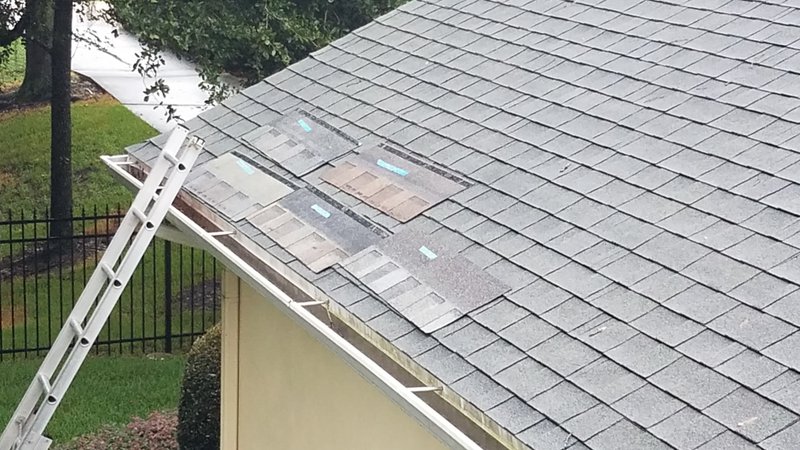Food, clothing and a roof over your head most would agree are basic needs. We're two out of three at our house. The soggy realization that our roof was kaput soaked in a few weeks ago.
"Uhhh, Honey?" I said, looking up from the kitchen table toward a brown splotch forming on the white ceiling.
DC followed my glance to the new, saucer-size water stain and said something I cannot print in a family newspaper.
And the phone calls began. Two inspections, one insurance claim and four roofing estimates confirmed:
This was not a patch job. We needed a whole new roof.
Insurance would cover the interior damage (drywall and paint), but the roof was on us, which was fair though unfortunate.
The roofers' estimates were all close in price and established that we weren't getting out of this for less than the cost of a Honda Civic, a nice wedding, or 35,568 cans of soup, which is what we'll be eating. We won't even talk about my dashed dream of new fall landscaping for the backyard. (Cue Taps on the bugle.)
However, if I must be grown-up about this, which I resent, the roof news wasn't a complete surprise. When we bought the Happier Yellow House two years ago, the home inspector said the roof had only a few good years left. Asphalt shingle roofs in Florida's hot, humid, hurricane-ridden climate typically last 15 to 20 years. Ours had been broiling now for 16.
I looked for the silver tarp in all this. "Maybe we can improve our home's curb appeal," I said to DC hopefully. "I mean, we could get something besides boring gray asphalt shingles." DC didn't answer.
As the fresh damp ceiling ring swelled over my head like a cloud of doom, I investigated my options.
The roofers were unanimous in their opinion: Stick with asphalt shingles. The most popular roofing material in the United States, asphalt shingles are economical, practical and work with a lot of traditional house styles. Tile, metal or slate roofs, though they last longer, cost a lot more and are heavy; many houses (including ours) aren't built to support them. Wood shingles, a good fit for ranch or rustic houses, can develop algae in moist climates.
Though I couldn't change the type of shingle, I could still change the color. I surveyed the sample board's 18 choices to see what might best top off the HYH. The many grays ranged in value from Mist White to Charcoal Black. In between were bold color options like Atlantic Blue, Hunter Green and Cottage Red. Hmmm. I felt my knees giving way and called my brother.
A Los Angeles-based design architect, Craig Jameson makes these decisions every day. He brought me to my senses, as he often does. "It's OK to be gray," he said, then offered these points to consider when choosing a new roof color:
Look at what you have. Replacing your roof with the type of material you already have is generally safe since builders typically choose the right material for a house's architectural style, structural support, color palette and location, he said.
Consider climate. Shingle color can affect your home's temperature and, depending on your insulation, energy bills. Black attracts and retains heat making attics hotter. A lighter roof will reflect sun and keep interiors cooler.
Factor in house colors. Your roof needs to be part of your home's color composition. For instance, red brick houses look nice with dark brown, deep gray or black shingles. Light gray houses look smart with dark gray roofs. Beige or cream houses can work with brown, warm gray or even colored shingles.
Don't make a statement. Your roof should not be the first feature folks notice. "A roof is meant to be in the background," Craig said. "A very dark roof will be more pronounced. A light roof will compete with the facade for attention, which is why midtones are most popular." Our yellow house has white trim and black shutters. When looking at it, Craig pointed out, you first see the burnt-orange front door and the oval window above it. Next, your eyes go to the white trim and black shutters. Then you notice the rest of the house. The midgray roof you see last, which is as it should be.
Get large samples. Do not choose your roof color from a small color chip, or from colors on a computer screen. Get two or more large samples, and see the color in your light on your roof, at different times of day.
Aim for variation. Homogenous colored shingles look flat. You want shingles that have a slight variation in color to give the roof some dimension, but not so much it looks like a checkerboard.
Mind your neighbors. Look at the roofs around yours and choose a shingle color that harmonizes. Don't make it match, but do make it blend. Clear your choice with your homeowner's association, if you have one, and make sure it complies with any subdivision rules.
Still not sure? Take a picture of your house. Print out several color copies, and, using colored pencils, color the roof in different shades.
After considering a gamut of color options, I chose, thanks to Craig's sound advice, medium gray (Colonial Slate) asphalt shingles in almost exactly the same color as the shingles we're replacing. Though change is fun, sometimes boring is best. Picking a roof is one of those times.
Syndicated columnist Marni Jameson is the author of five home and lifestyle books, including Downsizing the Family Home — What to Save, What to Let Go.
HomeStyle on 08/24/2019
